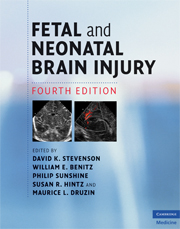Book contents
- Frontmatter
- Contents
- List of contributors
- Foreword
- Preface
- Section 1 Epidemiology, pathophysiology, and pathogenesis of fetal and neonatal brain injury
- Section 2 Pregnancy, labor, and delivery complications causing brain injury
- 5 Prematurity and complications of labor and delivery
- 6 Risks and complications of multiple gestations
- 7 Intrauterine growth restriction
- 8 Maternal diseases that affect fetal development
- 9 Obstetrical conditions and practices that affect the fetus and newborn
- 10 Fetal and neonatal injury as a consequence of maternal substance abuse
- 11 Hypertensive disorders of pregnancy
- 12 Complications of labor and delivery
- 13 Fetal response to asphyxia
- 14 Antepartum evaluation of fetal well-being
- 15 Intrapartum evaluation of the fetus
- Section 3 Diagnosis of the infant with brain injury
- Section 4 Specific conditions associated with fetal and neonatal brain injury
- Section 5 Management of the depressed or neurologically dysfunctional neonate
- Section 6 Assessing outcome of the brain-injured infant
- Index
- Plate section
- References
15 - Intrapartum evaluation of the fetus
from Section 2 - Pregnancy, labor, and delivery complications causing brain injury
Published online by Cambridge University Press: 12 January 2010
- Frontmatter
- Contents
- List of contributors
- Foreword
- Preface
- Section 1 Epidemiology, pathophysiology, and pathogenesis of fetal and neonatal brain injury
- Section 2 Pregnancy, labor, and delivery complications causing brain injury
- 5 Prematurity and complications of labor and delivery
- 6 Risks and complications of multiple gestations
- 7 Intrauterine growth restriction
- 8 Maternal diseases that affect fetal development
- 9 Obstetrical conditions and practices that affect the fetus and newborn
- 10 Fetal and neonatal injury as a consequence of maternal substance abuse
- 11 Hypertensive disorders of pregnancy
- 12 Complications of labor and delivery
- 13 Fetal response to asphyxia
- 14 Antepartum evaluation of fetal well-being
- 15 Intrapartum evaluation of the fetus
- Section 3 Diagnosis of the infant with brain injury
- Section 4 Specific conditions associated with fetal and neonatal brain injury
- Section 5 Management of the depressed or neurologically dysfunctional neonate
- Section 6 Assessing outcome of the brain-injured infant
- Index
- Plate section
- References
Summary
Introduction
The preliminary estimate of total births in the USA for 2005 was 4,138,349. Intrapartum fetal heart-rate (FHR) monitoring was used in more than 85% of the deliveries. Fetal heart-rate monitoring was introduced into clinical practice in the 1970s. At that time, obstetric providers and researchers in fetal physiology believed electronic fetal monitoring (EFM) would identify changes in the FHR and/or rhythm that reflect fetal acidosis. It was presumed that detection would be early enough to allow clinical intervention that would prevent perinatal asphyxia. Despite 30 years of widespread use and multiple randomized clinical trials, FHR monitoring has not yet been shown to decrease perinatal mortality other than by decreasing intrapartum fetal deaths. Moreover, some experts believe that the use of EFM leads to over-detection of non-reassuring FHR patterns, thereby directly contributing to the escalating rate of cesarean-section deliveries in the USA, which by 2005 increased to 30.3%. We will review the physiology underlying FHR patterns, and the possible reasons why randomized trials of EFM have so far failed to demonstrate efficacy. The current knowledge that guides interpretation of EFM in the intrapartum period will be discussed, with special emphasis on newer methods for intrapartum fetal surveillance.
- Type
- Chapter
- Information
- Fetal and Neonatal Brain Injury , pp. 174 - 186Publisher: Cambridge University PressPrint publication year: 2009
References
- 1
- Cited by



